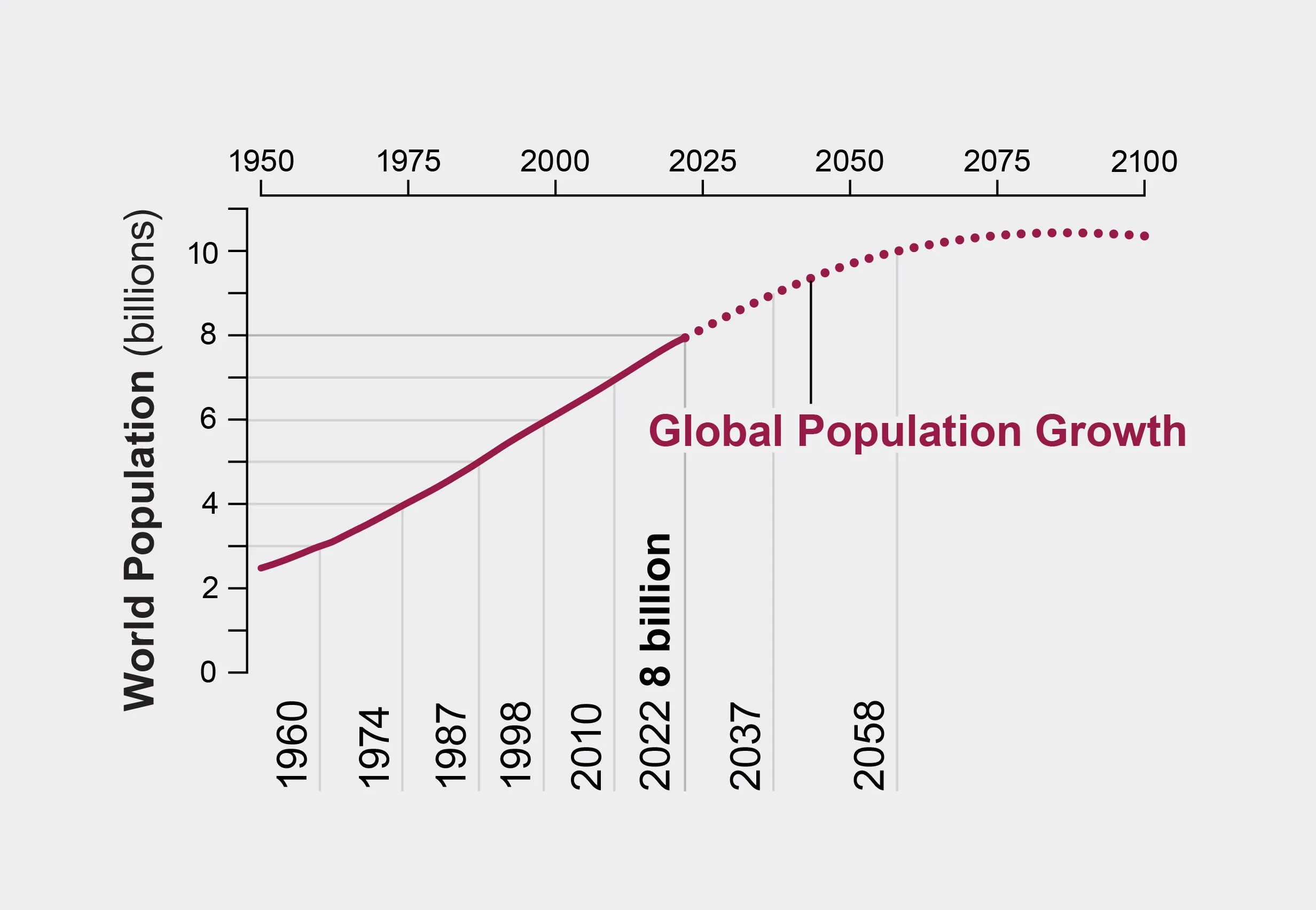Population Trends
What is the Demographic Dividend?
- Definition: A period when the working-age population (15–64 years) is higher than the dependent population (children and elderly), leading to a potential economic boost.
- India’s Advantage: As of 2006, 62% of the population was in the working-age group. It is expected to peak at 67.3% by 2050.
- This window of Demographic Dividend will close post-2050, after which ageing begins.
Population Growth and Historical Context
- India’s population is the largest in the world at 34 billion.
- The Year of the Great Divide – 1921:
- Marked the beginning of declining death rates.
- Shift from stagnant to rapid growth: 1901-1921 saw a rise from 30 cr to 32.2 cr.
- Post-1921: Population grew 6-fold in a century.
Projected Demographic Changes
- Population Increase: Additional 20–30 crore people expected by mid-21st century.
- Ageing:
- In 2006, 5% of the population was aged above 60.
- Requires new tax structures, social security, and geriatric healthcare
- Urbanization:
- Urban population to rise from 300 million (2000) to 600 million (2050).
- Will demand massive infrastructure investment (water, housing, traffic, etc.)
- Population Density: From 345/sq.km (2006) to 504/sq.km (2050) – stressing land and resources.
Population Stabilization: The TFR Factor
- Population Stabilization: When birth rate equals death rate for a prolonged period.
- TFR (Total Fertility Rate):
- Replacement-level fertility = 1 (ideal for stabilization).
- India aimed for this by 2010, stabilization by 2045 (as per National Population Policy, 2000).
- Now pushed to 2060, as per Health Ministry estimates.
State-wise TFR Disparities
- National average may hide regional disparities:
- Southern states reached replacement levels early.
- Hindi heartland (Bihar, UP, MP,
Rajasthan) lag
significantly:
- UP may reach TFR 2.1 only after 2100.
- Bihar by 2030, Rajasthan by 2048.
- Such disparities distort national demographic planning.
Regional Burdens and Migration
- Between 1991–2050, India's population
will grow by
773 million.
- UP alone will contribute 198 million (~25%).
- This growth in poorer states will lead to:
- Intra-national migration towards cities and richer states.
- Urban stress, job competition, and possible social unrest.
- Challenge to maintain social cohesion and integration.

Will India Miss the Window of Opportunity?
- If not addressed, India may lose its demographic dividend like China.
- Stephen Howes (World Bank, 2005): States like Bihar, UP, MP, Odisha, WB may have < $1000 per capita income by 2050 — worse than 2000.
- India had 245 million youth (15–24) in 2020 – lost potential if unutilized.
Policy and Economic Implications
- Missed Investments: Since 2000,
lack of large-scale
reforms in:
- Education
- Healthcare
- Employment creation
- Policy Focus Needed:
- Skilling youth to ensure labour productivity
- Planning for ageing welfare
- Investing in sustainable urbanization
- Ensuring balanced regional development
Other Terminology related to Population:
- Silver Tsunami
- Meaning: A metaphor for the rapid increase in the elderly population across the world.
- Use: Indicates the overwhelming pressure this will put on healthcare, pensions, and social welfare systems.
- Example: Japan and South Korea are already experiencing the silver tsunami with more than 25% of their populations over 65.
- Demographic Trap
- Meaning: A situation where a country remains stuck in high fertility and high population growth, without corresponding economic growth.
- Contrast: Opposite of demographic dividend.
- Example: Some African and South Asian countries risk falling into this trap due to poor human development investments.
- Gerontocracy
- Meaning: A political system where governance is dominated by older individuals.
- Relevance: As populations age, political power may become concentrated in the hands of the elderly, potentially resisting youth-centric reforms.
- Demographic Resilience
- Meaning: A country’s ability to adapt to demographic changes—whether ageing or shrinking population—through policy, innovation, and institutional strength.
- Global Use: Highlighted by UNFPA and WHO in discussions on sustainable population policies.
- Second Demographic Dividend
- Meaning: Economic gains that can occur after the first dividend, if the ageing population is healthy, skilled, and productively engaged.
- Policy Focus: Encourages lifelong learning, healthy ageing, and retirement reforms to extend economic productivity.
- Ageing Society → Aged Society →
Super-aged Society
- UN Classification:
- Ageing Society: >7% of population over 65
- Aged Society: >14%
- Super-aged Society: >21%
- Current Status: Japan and South Korea are already super-aged; India is heading toward becoming ageing by 2036.
- UN Classification:
- Youth Bulge
- Meaning: A demographic pattern where a large share of the population is comprised of youth (15–24).
- Challenge: If unskilled and unemployed, this can lead to instability, unrest, and frustration.
- Opportunity: Can become a demographic dividend with the right investment in education, skills, and jobs.
- Sandwich Generation
- Meaning: Adults who simultaneously care for their children and elderly parents.
- Impact: Causes emotional, economic, and mental stress—especially in urban nuclear families.
- Relevance: Growing trend in India due to rising life expectancy and ageing parents.
- Demographic Time Bomb
- Meaning: A scenario where a shrinking workforce and increasing dependency ratio lead to economic stagnation.
- Often used for: Countries like China, Italy, and Germany with declining fertility rates and rising aged populations.
- Productive Ageing
- Meaning: Concept promoting continued economic and social contribution by the elderly post-retirement.
- Strategies:
- Part-time roles
- Senior entrepreneurship
- Volunteering
- Intergenerational mentoring
- Policy Suggestion: Governments should redefine retirement to harness this productive capacity.
- Replacement Migration
- Meaning: Migration policy where young immigrants are used to compensate for declining birth rates and ageing populations.
- EU and Japan are exploring this model to balance shrinking workforces.
- Fertility Rebound
- Meaning: A temporary or policy-induced rise in fertility rates in countries where TFR has fallen too low.
- Seen in: Scandinavian countries with strong family support systems and gender-equal policies.
- Dependency Ratio Inversion
- Meaning: When the elderly outnumber the working-age population, reversing the traditional demographic pyramid.
- Visual Shift: The population pyramid becomes a “pillar” or even an “inverted triangle”.
- UPSC Relevance: Profound implications for fiscal policy, pensions, and healthcare systems.
- Demographic Winter
- "Demographic Winter" refers to the socioeconomic consequences of sustained low birth rates and a rapidly ageing population, eventually leading to population decline, shrinking workforce, and economic stagnation.
- It is essentially the "cold end" of the demographic transition, when a country moves past its demographic dividend and starts suffering from demographic decay.
- Countries facing Demographic Winter:
- Japan (TFR ~1.3)
- South Korea (TFR ~0.72 – lowest in the world)
- Italy, Germany, Spain (TFR well below 2.1)
- China (TFR ~1.1 post-One Child Policy era)













